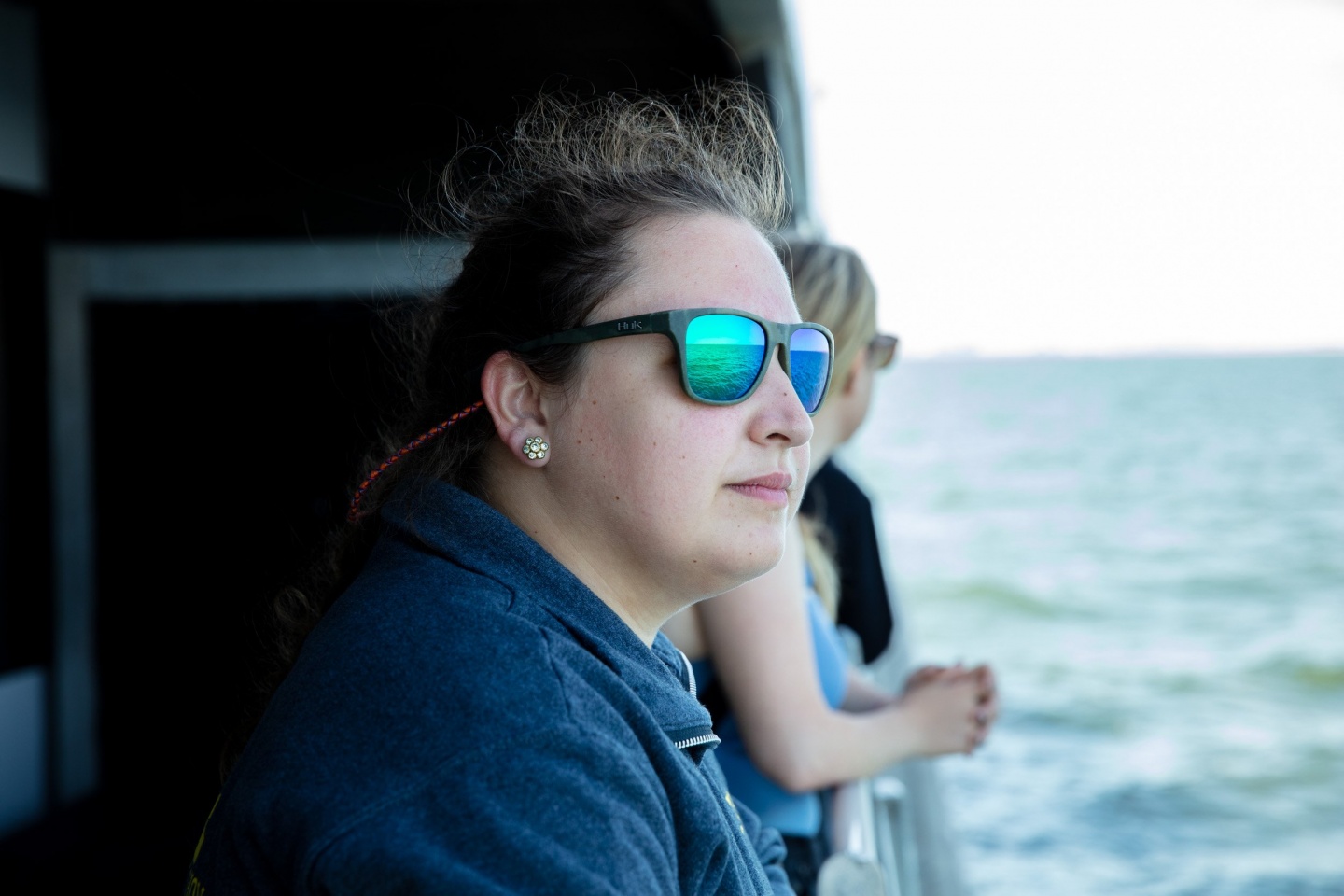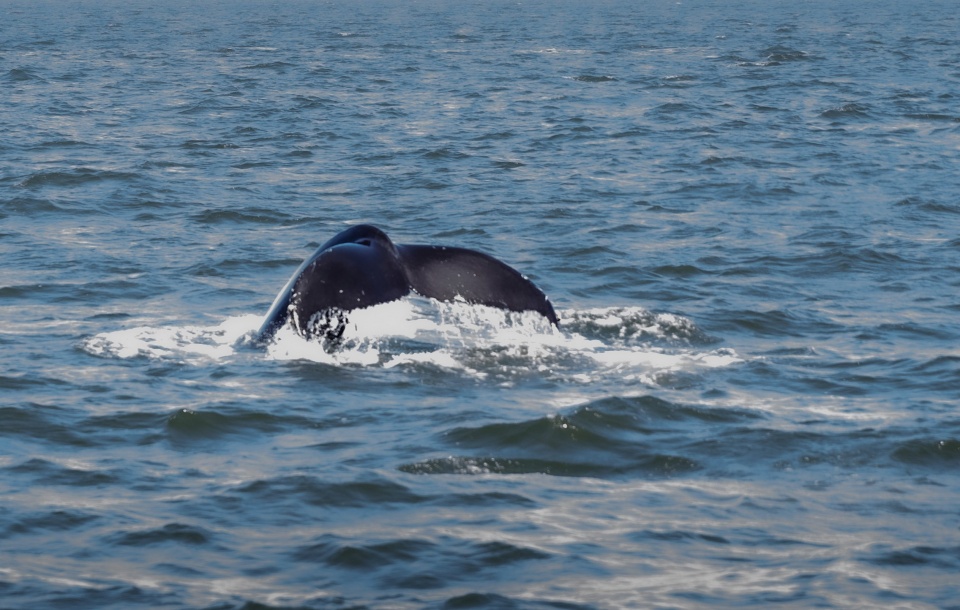Julia Zeh ’18 finds surprising proof of humpbacks near NYC.
Columbia College | Columbia University in the City of New York
Julia Zeh ’18 finds surprising proof of humpbacks near NYC.

Julia Zeh ’18’s findings provided the first acoustic proof that humpbacks spend time near NYC in winter.
ASHOK SINHA SEAS’99
It’s the Saturday of Labor Day weekend, cloudless and almost uncomfortably hot as Julia Zeh ’18 and I follow an angled walkway to Slip 5 at the Battery Maritime Building. A massive arch casts welcome shade before we again emerge into the sun. Here at the southern tip of Manhattan, the view is primarily of water, metal ramps and bobbing docks. Most visitors to this terminal are day-tripping to Governors Island; ours is a lesser-known tourist activity. We are going on a whale watch.
The whales in question are humpback whales, gentle giants known for their eerie undersea singing. The population that — surprisingly! — favors New York City feeds at northern latitudes in the summer and migrates south through the mid-Atlantic before wintering in the Caribbean. Zeh, a Syracuse doctoral student in biology, knows their vocalizations well. When she was an undergraduate, she analyzed more than 6,300 hours of recordings taken in these waters, listening for the distinctive music that would indicate their presence. Though sightings have increased in recent years, Zeh’s findings provided the first acoustic proof that humpbacks spend time here and, even more significantly, that they’re here in winter, when they aren’t expected to linger.
To be honest, I’m wondering if we’ll see anything today. The idea of whales swimming mere miles from the sky-high bustle of Manhattan is hard to square. Zeh acknowledges the mental leap; New England, Hawaii, those are the places to whale watch. But she’s cheerfully game to join a reporter for the ride while talking about her remarkable research. It’s not every day that the findings from a senior thesis lead to a published article in a peer-reviewed scientific journal, or get picked up by The New York Times. Zeh’s did both.
The boat arrives and we settle into an air-conditioned seating area; we practically have the space to ourselves, as most of the passengers are already jockeying for prime spots on the top deck. Soon we’re speeding south, past the Statue of Liberty, under the Verrazzano-Narrows Bridge. On the loudspeaker, a nature guide explains we’re in New York Bight, the triangular body of water between New Jersey and Long Island. He encourages everyone to keep their eyes on the horizon and watch for spouts — thar she blows! — adding that the immense spray is actually a mix of air, water and mucus, let out when the whale surfaces and exhales.
“It’s really smelly, like fish,” Zeh whispers with a laugh. She speaks from experience, having done field research tagging whales in Hawaii and Brazil, and off Cape Cod. However, the majority of Zeh’s studies are sonic — in her case, marine bioacoustics.
“The first time I listened to underwater sounds was just incredible,” she says. “That’s not normally an experience we get.” She describes the crackling sound of snapping shrimp and the low-frequency grunts of fish. “But whales are definitely the loudest.”
“Sound travels faster underwater than in air, and animals can communicate over really long distances. All of that makes for really interesting study.”
I ask what they sound like and she sighs. “I mean, it’s weird. The sounds they make are really weird. There are screeches and groans and moans and shrieks. But the really cool thing about whale song is that it’s repetitive and it’s structured — there’s a rhythm and pattern to it. So it’s cool to listen and try to parse it out: What important information are they maybe sharing with other whales, and how can we measure that? And why does it change, why does it evolve year to year?”
It doesn’t take long to realize Zeh loves asking these questions. A self-described interdisciplinarian, she gushes about the Core Curriculum before pausing to joke she must sound like a Columbia brochure. Still, she discovered a definite bent for science in high school (she fondly recalls an early project on coral bleaching, and the summer spent as a docent at the New York Aquarium). At the College, she majored in environmental biology but never considered marine bioacoustics until her senior thesis; the field excited her as a way to combine her interests in ecology and physics. “A lot of marine species don’t have other senses they can rely on for communication,” she says. “Think of it: Most of the time in deep water or murky water you can’t see, and you especially can’t see over long distances. Same with smell. But sound travels faster underwater than in air, and animals can communicate over really long distances. All of that makes for really interesting study.”
She went on to make several key connections — in Howard Rosenbaum, director of the Ocean Giants Program at the Wildlife Conservation Society and an adjunct E3B faculty member, and his WCS colleague, Melinda Rekdahl (both became co-authors on Zeh’s paper). Rekdahl trained Zeh in bioacoustics research and turned her onto an opportunity to dive into acoustic recordings captured in New York Bight in 2008 and 2009. Taken by Cornell researchers, the archived recordings were some of the first studies of marine mammals off New York. Scientists at the time had been mostly interested in using them to identify right whales, but Zeh and colleagues wondered, What if someone reanalyzed the data at a finer scale, with an ear out for humpback whale vocalizations?
“What made it so cool is that it was thousands of hours of continuous, long-term data,” Zeh says. “You can’t do that with any other method. You’re not out there looking for whales overnight, or in bad weather. It provides a much more complete picture.”

The V-shaped part of every whale’s tail is unique.
ASHOK SINHA SEAS’99
“The January song was what I was really excited to hear,” recalls Zeh, who hadn’t expected to find instances in winter; humpbacks by then are typically serenading potential mates in the Caribbean. She immediately brought it to Rekdahl’s attention; “When Mindi got excited, I thought, ‘Oh! I found something real.’”
Zeh ultimately documented humpback song for longer than anticipated stretches of the year, and found more evidence of singing at night than during the day. Her findings suggest that New York Bight may be an important feeding ground for whales, which raises many questions: Are humpback migratory patterns changing, and if so, why? What would an increased whale presence mean for the intense NYC shipping traffic and other industrial activity? Humpbacks aren’t endangered, but the population that swims near New York is, so how can they best be protected?
Zeh also has plenty of questions about humpback song itself, which is what’s driving her Ph.D. research: how their vocalizations develop over time, from infancy to adulthood, and where their song fits in an evolutionary context. Eventually, she hopes to be a college professor.
By now, the boat has slowed; we’re in humpback territory. Zeh and I head to the deck and snag a narrow space along the port side. She notes that we’re lucky to have such calm waters because it can be tricky to discern one type of splash from another. I’m still feeling doubtful of a sighting when I hear a collective intake of breath from the people around me: There’s a whale, startlingly close. Its dark back surfaces and makes a slow-moving curve, then a whoosh of tail goes up in salute. The crowd cheers.
Zeh is all excited smiles. She points out that the V-shaped part of every whale’s tail is unique, then leans far out over the rail, looking. She says it could be five to 10 minutes before the whale comes up again for air. I think about what she told me earlier, that researchers have been studying humpback whale song for half a century, “but there’s still so much that we don’t know.”
We put our eyes to the horizon, and we wait.

Published three times a year by Columbia College for alumni, students, faculty, parents and friends.
Columbia Alumni Center
622 W. 113th St., MC 4530, 6th Fl.
New York, NY 10025
212-851-7852
cct@columbia.edu

Columbia Alumni Center
622 W. 113th St., MC 4530, 4th Fl.
New York, NY 10025
212-851-7488
ccalumni@columbia.edu